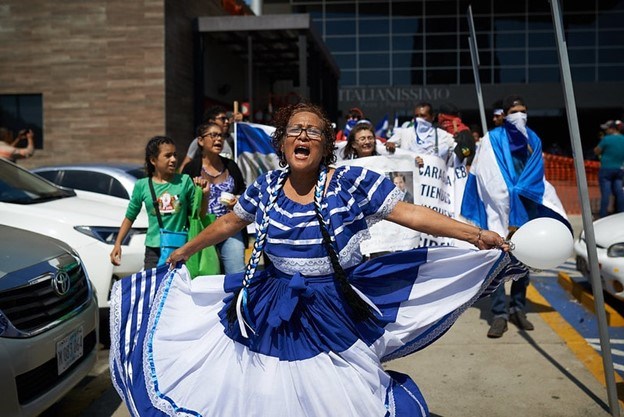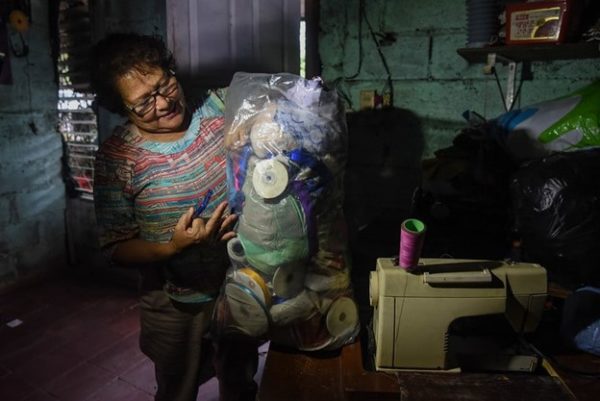Flor Ramírez: “I fled Nicaragua to save my life”

For opposing Ortega she suffered constant harassment and police persecution for three years. She is now in the United States, where she has requested asylum.
HAVANA TIMES – Three years of constant harassment, persecution, and threats, added to arbitrary detentions and beatings by people linked to the regime of Daniel Ortega and Rosario Murillo, motivated Flor de Maria Ramirez, known since the citizen protests of 2018 as the “lady of the huipil,” (folkloric dress) to flee Nicaragua to “save” her life.
Ramírez, 66, left the country in mid-April accompanied by one of her sons. She left her home in Managua at about 2:00 a.m., because the police who were stationed outside her house arrived daily at 5:00 a.m.
“We left on Easter Saturday. We left before the police officers arrived, and we made sure there were no civilians, because they also sent people to keep guard. We left in a hurry, took a taxi and said goodbye, amidst fear and tears, about our home,” Ramirez told Confidencial.
Ramirez left the country through an illegal crossing in the border area of El Guasaule, in Chinandega, between Nicaragua and Honduras, with the help of “a friend,” who asked her for ten dollars to take her along a path that is poorly guarded by immigration authorities of both countries.
She emphasized that for the entire trip, she had 900 dollars which she got from the sale of furniture, electrical appliances and sewing machines that she had in her business in Nicaragua.

After crossing into Honduran territory, she continued, moving in several buses, and on the morning of April 17 she was in Guatemala. There, she arrived after paying 20 dollars to a woman who, seeing that they could not afford to pay what the “coyotes” in the area were charging, offered to cross them at a point not very well guarded.
Detained in Guatemala
“Once in Guatemala we paid 200 dollars to a taxi that took us to the bus station to go to the capital. They pay bribes to immigration agents that they run into, and that is how we got to take a bus that would take us to the capital of that country. However, some policemen stopped the bus, asked for our papers, and since we did not have permission to travel, they detained us that same afternoon,” Ramirez regretted.
She affirmed that the police who detained them were “hostile” and, although there were no blows, they “mistreated” them.
“They took us to a nearby station and there I begged them to let us go, that we were fleeing Nicaragua because the dictatorship was persecuting us, but they mocked us. They told us that they were going to take us to a shelter and what they did was to take us back to the Honduran border. I complained about what they were doing, and they threatened me by saying that if I continued complaining they would send me back to Nicaragua,” she denounced.
“It was difficult. I cried at that moment, because it seemed to me that I was with the Nicaraguan police. The only thing those Guatemalan policemen didn’t do was beat me, but they did shout at me and humiliated me,” she added.
Ramírez and her son, despite being returned to the Honduran border, did not give up on continuing their journey to the United States. The woman said that after crying and praying for about an hour sitting on a sidewalk next to the border post, a young man approached her to offer to cross back into Guatemala, asking her to give him what she could.
“A boy came up to me and said: ‘mother, do you want to cross? Don’t cry. If you trust me, I’ll take you.” We went with him, he got us across and that same night we were again in Guatemala. We only paid him 50 quetzales—about 6.50 dollars—which in the end was what he asked for, although at the beginning he said to give him whatever we could,” she explained.
In this second attempt, Ramírez decided to take another route to avoid being detained again by Guatemalan authorities. She moved in up to five minibuses, which took alternate routes to the main highways, to get to the capital, and then to the border region between Guatemala and Mexico.
“I entered Mexico in the area of Tapachula. We found a person who crossed us for 70 dollars, because they charge much more there,” she commented.
More than a month in Mexico
It took Ramírez more than 30 days to reach the border area between Mexico and the United States. She spent a month in the state of Chiapas, on the border with Guatemala, to apply for a humanitarian visa and travel “more peacefully” through Mexican territory.
“We rented an apartment for a month, it was 120 dollars, and we began to apply for the humanitarian visa. It was a lengthy process because we arrived on April 20 and they didn’t give it to us until May 25,” she said.
“With the humanitarian visa, Ramírez resumed the journey to the United States. On May 26, with her son, she took a bus directly to Mexico City and then, without resting, another to Acuna, a border area with the United States, where they arrived the following day.
Ramírez crossed the Rio Bravo on the morning of May 20. She claims that it was “a very difficult” moment and before entering the waters “I entrusted myself to God.”

“Immigration grabbed me at around nine in the morning. They were some gringos traveling in a van. They ran into us in some cornfields, in US territory. They asked something in English, and I told them in Spanish: ‘we are Nicaraguans and we are fleeing from Nicaragua.’ They did not ask us anything else, they opened the van and took us to a place where they were taking migrants they were grabbing,” she said.
The “lady of the huipil” was only held for three days by US immigration authorities in Del Rio, Texas. “My release from the detention center was like a Mother’s Day gift, because on the same (May) 30 they told me to get ready, that I was leaving,” Ramírez commented.
She explained that before leaving they asked her for an address where she could be reached, and she gave one of a friend. They gave her a cell phone with which they monitor her every week, through photos and geolocation. And they gave her five days to move to the place she would be staying while she faces the asylum application process.
Ramírez said that she now she awaits for a positive result for her application and for a job opportunity to materialize, because, although she loves Nicaragua, “I can’t go back, because my life is in danger there, the dictatorship no longer lets me live in peace.”
Never-ending persecution in Nicaragua
“Every day they arrived to harass me, they threatened me and my family. They told me that if they found me in the street, they were going to arrest me or disappear me. I could no longer work, nobody came to my sewing shop because of the siege. And if I went out to look for something, they followed me or investigated to find out where I was. I could not go out because the Police were right behind me. I would get on a bus, then a taxi, that was my life, walking, running, and I no longer wanted to live like that,” said Ramirez as her voice cracked.
Dona Flor, as those who know her affectionately call her, began her participation in the protests on April 20, 2018. In August of that same year, she decided to support the marches by wearing a blue and white huipil, in honor of a young woman who was arrested that month for dancing folklore at a sit-in held outside the Universidad Centroamericana (UCA).
The “Lady in the huipil” was first arrested by the Ortega regime’s police in September 2018. On that occasion, a policeman shouted at her: “If you don’t shut up, I will shoot you and I am going to make you disappear,” while she was being taken to the infamous El Chipote interrogation jail, where she was photographed and threatened if she didn’t stop protesting.
The Inter-American Commission on Human Rights (IACHR) in August 2021, granted precautionary measures in favor of Ramírez, warning that her physical integrity and life were in “extreme gravity and risk,” due to the “constant harassment, threats, persecution and physical attacks” she was suffering.





